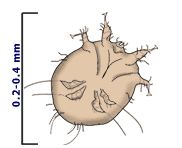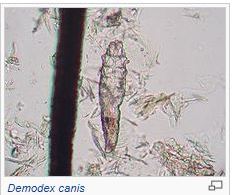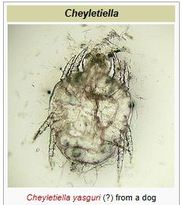Mange
Brought to you by 'Maxhealth' - a good quality food that can assist with skin related conditions
www.maxhelath.co.za
Feeding a good quality food to keep your dogs immune system strong, maintaining good hygiene by way of flea prevention, regular baths and brushing and keeping your dog away from dogs that are infected with this condition will greatly reduce the chances of your dog contracting this condition.
Although there are so many species, very few types of mange are actually contagious from dog to dog, and from dog to human (zoonosis)

www.petsbestrx.com
When I hear somebody mention the word ‘mange’, I actually cringe! I have seen so many dogs with this condition in rescue shelters - it really is a horrible condition and definitely one to avoid. It eats away at the skin, causes intense itchiness, and pain and misery in the infected dog. No matter how much an owner loves their dog, a dog with a bad dose of mange, is not a dog you want to cuddle, or even touch in some cases, especially as some types of mange are contagious.
What is Mange?
Mange (from Middle English majeure, from Old French manqué, from mangier, meaning to eat), is a general term for several types of parasitic (living of the hosts body) mite infections. The Merrian-Webster Online Dictionary describes mange as “various persistent contagious skin diseases marked especially by eczematous inflammation and loss of hair, affecting domestic animals or sometimes humans (zoonotic - transferable from animals to humans), and caused by a minute parasitic mite”.
What is a mite?
Now you may ask ‘what is a mite’? A mite is a microscopic arachnid (seldom seen with the naked eye and so often goes un-noticed) and is related to the tic. These mites can be found in a large array of different habitats such as plants, soil, water, insects, animals and reptiles. In research I came across, it is estimated that there are approximately 48,200 species of mites. Although there are so many species, very few types of mange are actually contagious from dog to dog, and from dog to human (zoonosis).
These mites can do so much damage that one might think that the term The Mighty Mite was applicable to the parasitic mite mentioned here, rather that the terminology for the Jeep vehicle designed for the U.S. military after World War 11!!
Mites either burrow below the dogs skin or enter next to a hair follicle. In fact, just about every dog has the Demodex canis mite present in its system and if the dog is healthy, has a strong immune systems, mange rarely appears. However, when a dog’s immune system is weakened, the skin is infected and mange is more likely to occur. In rescue situations especially, pups often contract mites from their mothers, who may either have mange due to a genetic predisposition to demodectic mange, or from being fed low grade food and having been in contact with other infected dogs. In this case, often the pup’s immune systems are not strong enough to deal with the mite, and mange will occur. Mange will further weaken a dog’s immune system which makes the dog more susceptible to other illnesses.
There are different types of mange i.e. sarcoptic mange, cheyletiella mange and demodectic mange.
Is it possible to prevent mange?
As prevention is always better than cure, keeping your dog away from dogs that are unwell, or are exhibiting systems of mange, is your number one preventative.
Feeding your dog a good quality food and ensuring that it is in good health with a strong immune system and undergoing regular vaccinations will assist in keeping the immune system strong. As this condition seems to target dogs with weakened immune systems, take your dog to the vet if any illness occurs or is suspected. Engaging, and continuing to keep in place a good flea program as well as regular baths and brushing will assist in keeping this condition at bay.
High stress may cause outbreaks of demodectic mange, especially if the dog is recovering from mange and is still susceptible to further outbreaks.
If you have a dog that has Sarcoptic mange or work or are involved in working with dogs in a rescue shelter where the condition is more likely to be found, ensure that your wash your hands with a product that will kill the mites, change your clothes before going home and build up your immune system by taking a daily multi-vitamin supplement, healthy eating and drinking sufficient water. By having a strong immune system, your body’s immune system will be able to fight off any sarcoptic mites before they have the opportunity to bury under your skin and lay their eggs. The symptoms in humans are less severe than in dogs, as the mites cannot complete their life cycle in human skin. If you do suspect you have been infected, visit your doctor for treatment immediately.
As mentioned above with humans, if you suspect that your dog may be starting a mange infection, a trip to your vet, as early as possible is a necessity, as secondary bacterial infections can occur and this condition can spread unbelievable quickly.
What are the signs of a mange infection?
Depending on what type of mite has infected your dog, the symptoms may be slightly different and the condition is more likely to target the areas of the dog that have less skin, such as elbows, face, legs, ears, but in a short amount of time it can spread to the entire body.
What is Mange?
Mange (from Middle English majeure, from Old French manqué, from mangier, meaning to eat), is a general term for several types of parasitic (living of the hosts body) mite infections. The Merrian-Webster Online Dictionary describes mange as “various persistent contagious skin diseases marked especially by eczematous inflammation and loss of hair, affecting domestic animals or sometimes humans (zoonotic - transferable from animals to humans), and caused by a minute parasitic mite”.
What is a mite?
Now you may ask ‘what is a mite’? A mite is a microscopic arachnid (seldom seen with the naked eye and so often goes un-noticed) and is related to the tic. These mites can be found in a large array of different habitats such as plants, soil, water, insects, animals and reptiles. In research I came across, it is estimated that there are approximately 48,200 species of mites. Although there are so many species, very few types of mange are actually contagious from dog to dog, and from dog to human (zoonosis).
These mites can do so much damage that one might think that the term The Mighty Mite was applicable to the parasitic mite mentioned here, rather that the terminology for the Jeep vehicle designed for the U.S. military after World War 11!!
Mites either burrow below the dogs skin or enter next to a hair follicle. In fact, just about every dog has the Demodex canis mite present in its system and if the dog is healthy, has a strong immune systems, mange rarely appears. However, when a dog’s immune system is weakened, the skin is infected and mange is more likely to occur. In rescue situations especially, pups often contract mites from their mothers, who may either have mange due to a genetic predisposition to demodectic mange, or from being fed low grade food and having been in contact with other infected dogs. In this case, often the pup’s immune systems are not strong enough to deal with the mite, and mange will occur. Mange will further weaken a dog’s immune system which makes the dog more susceptible to other illnesses.
There are different types of mange i.e. sarcoptic mange, cheyletiella mange and demodectic mange.
Is it possible to prevent mange?
As prevention is always better than cure, keeping your dog away from dogs that are unwell, or are exhibiting systems of mange, is your number one preventative.
Feeding your dog a good quality food and ensuring that it is in good health with a strong immune system and undergoing regular vaccinations will assist in keeping the immune system strong. As this condition seems to target dogs with weakened immune systems, take your dog to the vet if any illness occurs or is suspected. Engaging, and continuing to keep in place a good flea program as well as regular baths and brushing will assist in keeping this condition at bay.
High stress may cause outbreaks of demodectic mange, especially if the dog is recovering from mange and is still susceptible to further outbreaks.
If you have a dog that has Sarcoptic mange or work or are involved in working with dogs in a rescue shelter where the condition is more likely to be found, ensure that your wash your hands with a product that will kill the mites, change your clothes before going home and build up your immune system by taking a daily multi-vitamin supplement, healthy eating and drinking sufficient water. By having a strong immune system, your body’s immune system will be able to fight off any sarcoptic mites before they have the opportunity to bury under your skin and lay their eggs. The symptoms in humans are less severe than in dogs, as the mites cannot complete their life cycle in human skin. If you do suspect you have been infected, visit your doctor for treatment immediately.
As mentioned above with humans, if you suspect that your dog may be starting a mange infection, a trip to your vet, as early as possible is a necessity, as secondary bacterial infections can occur and this condition can spread unbelievable quickly.
What are the signs of a mange infection?
Depending on what type of mite has infected your dog, the symptoms may be slightly different and the condition is more likely to target the areas of the dog that have less skin, such as elbows, face, legs, ears, but in a short amount of time it can spread to the entire body.
a. DEMODECTIC MANGE(also called Red or Puppy mange)
Hair loss (bald spots due to hair falling out), sores, scaliness and scabbing can be caused by the Demodex mite, which, as mentioned above, is the mite that is present in most dogs. This mite is not transferred to humans but is harder to deal with as the mite tends to bury itself much deeper and pustules and legions can occur.
The weaker the immune system, the worse the mange tends to be. It is also called red mange or puppy mange. This condition seems to more common in either very young or very old dogs, or dogs that have a weakened immune system and is not as severe as the sarcoptic mange, as long as treatment is undergone as soon as the condition manifests.
For treating this condition your first port of call is your vet, where he/she will try to get several skin samples from different locations and try to squeeze out a mite to diagnose which type of mite is present. Your vet will then prescribe the treatment and will probably tell you to ensure that the dog is kept isolated to prevent infecting other dogs and cats, and to thoroughly wash the dogs bedding and surrounding areas with a residual insecticide.
Hair loss (bald spots due to hair falling out), sores, scaliness and scabbing can be caused by the Demodex mite, which, as mentioned above, is the mite that is present in most dogs. This mite is not transferred to humans but is harder to deal with as the mite tends to bury itself much deeper and pustules and legions can occur.
The weaker the immune system, the worse the mange tends to be. It is also called red mange or puppy mange. This condition seems to more common in either very young or very old dogs, or dogs that have a weakened immune system and is not as severe as the sarcoptic mange, as long as treatment is undergone as soon as the condition manifests.
For treating this condition your first port of call is your vet, where he/she will try to get several skin samples from different locations and try to squeeze out a mite to diagnose which type of mite is present. Your vet will then prescribe the treatment and will probably tell you to ensure that the dog is kept isolated to prevent infecting other dogs and cats, and to thoroughly wash the dogs bedding and surrounding areas with a residual insecticide.
b. Sarcoptic mange (also known as Canine scabies)

The Sarcoptic mange is one of the mites that can be passed onto humans and symptoms in humans are rash like symptom which looks very like mosquito bites, are very itchy and tend to get worse at night. Red blister can form on the hands, feet, elbows, wrists and back of knees.
In dogs, the signs include severe itching, hair loss and scaliness and it really does spread like wildfire with the dog tending to have a moth-eaten appearance as clumps of hair begin to fall out. This mite does not bury itself in as deeply as the demodectic mite and appears to become worse in warm conditions.
As above, the standard method is to perform a skin scraping and identify the mite under the microscope and then prescribe the necessary medication. However, the diagnosis of this type of mange is often based on symptoms rather than actual confirmation of the presence of mites as it is not as easy to obtain a mite to identify. Treatment involves isolating the dog, cleaning bedding and the surrounding environment with a residual insecticide.
b. Cheyletiellosis mange (also called ‘walking dandruff”)
In the research undertaken, many vets stated that they saw more of this condition than dogs infected with fleas. It seems that the newer, safer and more effective methods of flea control used today do not seem to eradicate Cheyletiella as the older pyrethrin-based products used in the past.
A dog infected with this mite is highly contagious and infestation is caused by direct contact with an infected dog. Unlike the two mites above, these particular mites do not burrow into the skin, but rather live in the keratin level. The reason it is called ‘walking dandruff’ is that on examination of the dog, the ‘dandruff’ can be seen moving – this is caused by the mites moving around under the scales.
One of the more common signs that your dogs has become infected is if it starts rubbing its face, both with its paws and against furniture etc and seems to be sneezing on a regular basis. Hair loss on the face, especially around the eyes and nose can be seen and with some dogs there is intense itching and extensive hair loss, both in the face area as mentioned above, and also in areas such as the neck, head and back.
Your vet will confirm the diagnosis, prescribe and prescribe treatment. What is often difficult for vets with this condition is that there are other conditions such as flea infection, allergies that mimic this condition, so skin scrapings are required here as well. The dog must be isolated and any other animals in the house treated as well. Bedding and surrounding area will also need to be treated to prevent re-infection.
By. S. Valadao
Resources.
Ackerman, L. Skin and Haircoat Problems in Dogs. Alpine Publications. Loveland, CO; 1994.
Fourie, LJ; Kok, DJ; Rugg, D; du Plessis, A. Efficacy of a novel formulation of metaflumizone plus amitraz (PromerisTM)
for the treatment of demodectic and sarcoptic mange in dogs. Presented at the 32nd Annual World Small Animal Veterinary Association, Sydney, Australia; Aug 23-27, 2007.
Griffin, C; Kwochka, K; Macdonald, J. Current Veterinary Dermatology. Mosby Publications. Linn, MO; 1993.
Jeromin,Alice DVM, Dipl. ACVD
Merrian-Webster Online Dictonary
Newbury, S; Moriello, KA. Skin diseases of animals in shelters: triage strategy and treatment recommendations
for common diseases. In Campbell, KL (ed.) The Veterinary Clinics of North America Small Animal Practice:
Updates in Dermatology. W.B. Saunders Co. Philadelphia, PA; 2006:78.
Scott, D; Miller, W; Griffin, C. Muller and Kirk's Small Animal Dermatology. W.B. Saunders Co. Philadelphia, PA; 2001.
wikipedia.org/wiki/Mite


